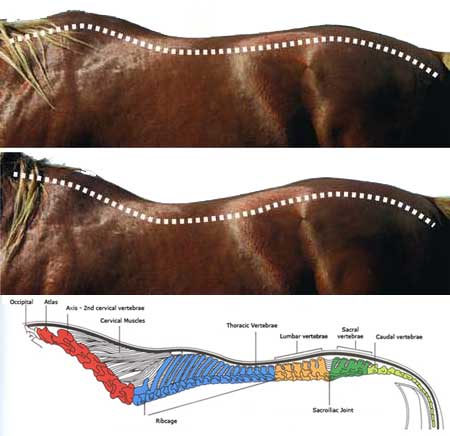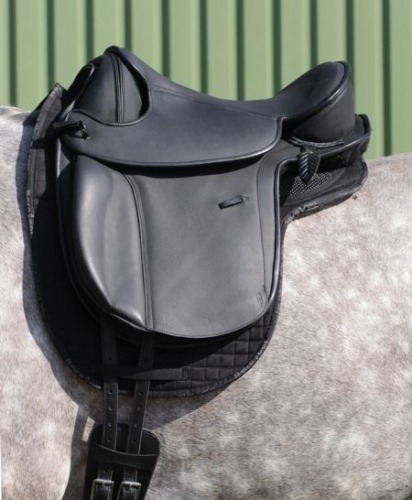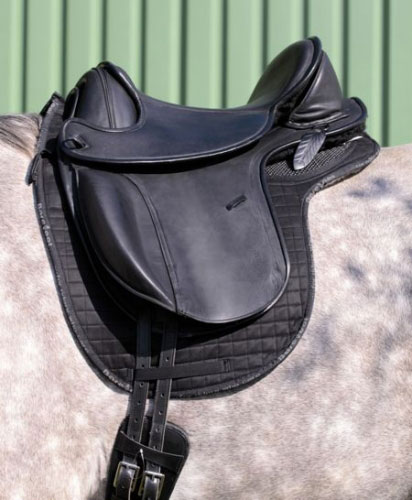FAQ
Barefoot Physiological System
The back of the horse is not naturally created to carry a rider and saddle.
Over the span of a lifetime, the back of a horse has a lot to bare. This is
why it's important as
riders who care, to take a closer look at the issue and review it from a physiological standpoint.
Only correct training under a well-fitting saddle enables a horse to
lift his back, and reach out far and powerfully underneath his center of
gravity. This action allows the necessary muscles to form, which stabilize
the columnar vertebrae - eventually turning the horse into a riding
horse. The thoracic vertebrae are most stable between the withers and
the 15th vertebrae. It is here that the horse can calibrate the weight
of rider and saddle the
best.
Sabine Ullmann, a German equine physiotherapist, decided after working
for years on horses with saddle related back problems, to use her
knowledge to create her own range of high quality saddles. With that, she designed the
Barefoot Saddles for the horse's comfort and to ensure a healthy back for the horse.
COMFORT FOR THE HORSE
All
Barefoot Saddles are designed anatomically to follow
the horse's topline, and are flexible in all dimensions -
without a
rigid tree
. These treeless saddles adjust themselves according to the horse's back,
and allow bigger strides out of the shoulder as well as lifting of the
back. Columnar vertebrae, as well as withers, stay free of pressure.
Additionally, under a
Barefoot Saddle, the shoulder and the loin area
aren't restricted. The
Barefoot Saddle positions the
rider into the perfect saddle area, between withers and the 15th vertebrae -
thus aiding the horse in equilibrating his weight.
COMFORT FOR THE RIDER
The
Barefoot Saddle allows a close contact feeling between horse and
rider, making it ideally suited for beginners, natural horsemanship, and even riders with a
handicap. The seat is comfortable and cushioned - ideal for a long ride.
The rider's back is also made comfortable thanks to the soft and
elastic way the horse's movements are transmitted.
 What is the VPS System?
What is the VPS System?
VPS stands for 'Vertebrae Protection System'. It consists of a
combination of different materials, some more pressure distributing
whilst others are more pressure absorbing. This includes sandwiching
shock absorbing
Elastomer layers and a pressure distributing Polymer
layer
. All materials are totally flexible, allowing the saddle to
instantly adjust to the horse's movements and any changes to the horse's
back. All materials have a smooth surface and beveled edges.
Barefoot
does not use upholstery material
which could compress unevenly and
create uneven pressure distribution. The VPS-System is not bulky and
does not interfere with the rider's communication through the aids.
WHY VPS?
VPS aids the best possible weight distribution in the area that can
carry weight, between the withers and the 15/16 thoracic vertebrae.
Pressure points are eliminated, as pressure readings prove. The soft
panel construction to the left and right of the spine allow for a
distinct spinal channel and provide spinal & wither clearance. The
rider's weight is still distributed over the whole saddle area.
 Differences: Barefoot vs Conventional saddle?
Differences: Barefoot vs Conventional saddle?
Not only does a
Barefoot Saddle look different from a conventional saddle but a Barefoot Saddle also functions totally differently because of its 'inner life' with its VPS-System.
Under a
Barefoot Saddle a horse can move freely, arch and lift
his back and allow a true sideways movement of the spine. The horse can
bend without having to avoid the pressure of a tree on his back.
The Barefoot is the most flexible saddle in the world. It can therefore
adapt, anytime, to any changes of the horse's back. A horse's back
mainly changes due to seasonal changes, training or age. The back also
changes shape (see illustration) during forward- upward movement when
the horse lifts and stretches his back.
A conventional saddle cannot keep up with the movement - it blocks at
least part of the back muscles and therefore buildup of muscles is not
possible and muscle atrophy is the end product. Under a
Barefoot Saddle, a horse can let go, relax his
muscles, stretch forward - upwards, without any pressure from above. The
horse learns to move without pain, and that moving under a saddle can be
fun!
We have often noticed that horses increase their tempo, and the strides
automatically become bigger. The horse suddenly offers what the
rider has tried to achieve, month after month through training.
 How Can Treeless Saddles Work?
How Can Treeless Saddles Work?
Every horse's back is different. The back of the individual horse will
change often during its lifetime through age, training, or seasonal
transitions. Whenever we ride, the horse's back is constantly in motion.
All
Barefoot Saddles are designed anatomically to follow
the horse's topline and they are flexible in all directions - without a
rigid tree. They adjust themselves ideally according to the horse's back
and allow freedom of the shoulder as well as lifting of the back.
Columnar vertebrae as well as withers stay free of pressure; also the
shoulder and the loin area aren't restricted. The Barefoot saddle
positions the rider into the perfect saddle area, between the withers
and 15th vertebrae, thus aiding the horse in carrying his weight.
The horse should ideally not have any weight bearing beyond T14 but
definitely no saddle should load the horse's loin area behind the last
rib (T 18). The area on the horse's back that is equipped to carry us the most
comfortably is between the 9th and 14th thoracic vertebrae. This area is
in fact a lot smaller than most of us think. This is particularly true
if you own a horse that is short in the back. The further we move away
from the horse's center of gravity the more likely it is that soundness
problems will occur. The
Barefoot Saddle wraps the rider's weight around the
horse's center of gravity. If you look at your buttocks and upper thighs
and compare the size of that area with the panels of a treed saddle you
might find that the treeless rider actually distributes his/her weight
over a larger area than the rider in a conventional saddle.
 Saddle Slippage & Security?
Saddle Slippage & Security?
For rounder, flatter shaped horses, we always recommend an English
rigging system over western rigging, as it provides additional hold, and
a saddle pad that helps with saddle slip like the Barefoot Physio
Saddle Pads. We always recommend a short girth or cinch. The shorter the
girth/cinch the more secure the saddle will fit. We recommend that you
girth snuggly, and re-tighten your girth after mounting.
We recommend you use a mounting block or other mounting aids (i.e. tree
stump, rock, etc.) when mounting your horse. It is better for your
horse's back and lessens the strain placed on his back and withers. With
some horses and treeless saddles, you will not be able to mount from
the ground safely.
SECURITY?
After adjusting to the different feel of a treeless saddle, you may
develop a new connection with your horse that gives both of you a more
secure feel. A treeless saddle does not provide any more security than a
treed saddle.
GIRTH POSITION?
The ideal girth position for a treeless saddle is shown in the picture
to the right. The arrow shows the position the girth should be when it
is tightened - just above the elbow of the horse's front leg. This
shorter style of girth/cinch results in a more secure saddle fit.
To ensure you get the correct girth size, measure with a measuring tape from a hand width above the horse's elbow on one side, down under the belly, to a hand width above the elbow on the other side. Girth lengths are always given from the end of one buckle to the end of the other. This measuring method ensures that buckles lie far enough above the elbows.
What Size?
Click here for our printable measuring template, a Step-by-Step Guide to correct pommel width for your horse.
Below is a chart with the measurements of each Barefoot Treeless Saddle (centimeters).
Please note, *clothes size is represented in European sizing.
A = Length of Saddle (total)
B = Length of Seat
C = Length of Saddle Flap
Barefoot Saddles are handmade. Each saddle is unique - minor differences are possible.
MORE Q & A
WILL MY BAREFOOT SADDLE FIT SEVERAL DIFFERENT HORSES?
Absolutely! Its flexibility is one of the biggest advantages of the
Barefoot: It will conform to just about any shape horse or mule, will
always fit, and often save you buying saddle after saddle for your herd.
If you have very different types of horses (some high-withered, some
round-backed), you may have to exchange the pommel arch or fork. This is
done by opening two zippers, exchanging fork, closing zippers again (it
nestles in there fairly sung), and takes less than 5 minutes. Extreme
differences may be accommodated with different blankets/pads.
Most average horses do well with the same, standard, medium-wide fork.
Weight changes from summer to winter are not a concern anymore, changes
in shape from muscling up during training don't require a new saddle,
blanket or stuffing. If you get a new horse you can start riding right
away, with confidence, and don't have to pay for professional saddle
fitting, alterations, a new saddle, or go through weeks of painful trial
and error.
CAN I MOUNT FROM THE GROUND?
Maybe. Try to use a mounting block, a rock, log, truck, fence, ditch,
bank, or just a handy slope in the terrain to assist you in mounting -
your horse will love you for it! Choosing a non-slip Barefoot Physio
Saddle Pad and non-slip girth or cinch will help.
For short-legged riders and very tall or round horses with no withers,
there are mounting aids available. These are straps that go around the
opposite foreleg, you put them on, mount, then unclip it from the saddle
and park it in its keeper buckle. There are also mounting stools that
fold up and go into a small carrying bag and attach to your saddle.
DO I NEED TO GET USED TO THE SADDLE?
It depends on your old saddle and style of riding.
Try out your new Barefoot Saddle in a safe enclosed area. Most
likely you'll just be blown away by the comfortable seat, by the big
swing in your horse's back and gaits, and by how easily your horse seems
to read your aids and cues now.
If you had an English saddle before, and have a wide-backed horse, you
may feel you're sitting wider in a treeless. This is because now you
feel the width of the horse's actual back, when before you were sitting
on top of a built-up, narrow twist. The muscles around your hip joints
or inner thighs may need to adjust to this, if you have become a bit
inflexible. Stretching warm up exercises before riding my help. Any
'stretched wide' feeling should disappear after a few rides. If you have
bad arthritis in your hip or other chronic hip problems, you can try to
fix this by customizing your saddle by building up the middle of the
seat with one or two layers of foam cut in a narrower shape and put
under the seat. Put seat back on with Velcro.
DOES MY HORSE NEED TO GET USED TO THE SADDLE?
No. But you may need to get used to your new horse! Don't ask too much
right away and ride in a safe enclosed area for the first couple of
rides. Most horses are very happy to be finally able to move freely and
without pain. This can lead to some exuberance on your first ride or two
- be prepared for a more spirited horse! And any new saddle may feel
just plain weird to a horse, plus the Barefoot allows it to feel what
you're doing up there, which may be feel odd the first time, too.
IS IT OKAY FOR YOUNG HORSES, TOO?
Absolutely! A Barefoot treeless saddle is suitable for starting and
training young horses! Thanks to the total flexibility of the saddle, it
can adjust to the horse's back while the horse changes shape through
growth and training. A horse undergoing training goes through a
pronounced transformation - the muscles get bigger, fat disappears, the
back develops. The Barefoot saddle will 'grow' with the horse.
IS THERE A BREAK-IN PERIOD FOR MY NEW TREELESS BAREFOOT SADDLE?
The saddle is soft, comfy, deep and flexible, and your posterior will
feel right at home in it. However, all those layers of foam and fleece
will compress over time and mold somewhat to you and your horse. This
may take a month or so, depending on how much you ride. During this
time, you need to re-tighten the girth a lot, until everything has
compressed and settled a bit.
(
This is shown in the graphics
below. The picture on the left is a brand new Barefoot Lexington. The
picture on the right is the same saddle after two weeks of riding. As
you can see, the saddle seat is deeper after having been utilized on a
horse
.)


I HAVE A GAITED HORSE, IS A TREELESS SADDLE SUITABLE FOR ME?
Absolutely! In fact, it is especially well suited for gaited horses: it
allows their backs and shoulders the freedom to move and gait.
CAN I USE THE HORN FOR ROPING, DRAGGING, OR MOUNTING?
No. It is solid, but contained in a zippered pocket, and the zippers
will wear out if you put too much force on the horn. You can use it for
stability when riding, or to hang a light horn bag from it, but don't
tie any animals to it, and don't haul yourself up in the saddle from the
ground on it. If you expect to do some roping, a treeless saddle is not
for you!
CAN I USE THE BAREFOOT TREELESS SADDLES FOR SHOWS AND COMPETITION?
It is always best to consult the rule book of any particular competition.
CAN I JUMP IN MY BAREFOOT?
If you are a regular and ambitious jumper, treeless saddles are not for
you. There is a lot of force put on the stirrup attachment when
landing, and this is better caught by a stiff tree. If you canter over a
cavellti or log on the trail now and then, it's not an issue.
IS THERE A WEIGHT LIMIT?
Generally speaking, yes, but there are exceptions. Riders that weigh
165-170 lbs and over can be successful in a treeless saddle depending on
what horse they are riding. This 170 lbs thresh hold can be stretched
with quality saddle pads and inserts, and the rider paired with a large
enough horse to carry them with the back musculature to support them.
I'M NOT SURE WHICH SIZE SADDLE TO ORDER.
If you're in doubt, go with Size Two. It takes a fairly petite person to be comfortable in a Size One.
WHAT ABOUT GETTING THE SADDLE BACK AND OFF THE SHOULDERS?
With a treeless, you don't need to worry about pinching the shoulders - everything is soft and flexible.
WHICH PAD AND ACCESSORIES DO I REALLY NEED?
Most important is a saddle pad with inserts. It is an integral part of
any treeless saddle system and plays a big role in its performance. With
all treeless saddles, you should use a saddle pad with shock absorbing
foam or felt inserts on either side of the spine, leaving the spine
channel clear.
WHAT KIND AND SIZE OF GIRTH OR CINCH DO I NEED?
The Arizona and Arizona Nut use a traditional western cinch. All other
models need a short dressage style girth because the saddles are
equipped with long billets.
To figure out which size you will need, measure with a measuring tape
from a hand width above the horse's elbow on one side, down under the
belly, to a hand width above the elbow on the other side. Girth lengths
are always given from the end of one buckle to the end of the other.
This measuring method ensures that buckles lie far enough above the
elbows.
For the Western cinch, measure with a tape, from two hand widths above
the horse's elbow on one side, down under the belly, to two hand widths
above the elbow on the other side. This measuring method ensures that
buckles lie far enough above the points of the elbows.
DO I NEED YOUR SAFETY STIRRUPS?
Safety Stirrups are your safest choice, but it's the rider's choice. In
a treeless saddle the stirrup leather or fender is fed through a solid
ring, so will not slide out. There are various English safety stirrups,
and cages for trail stirrups, and western tapaderos. These all prevent
the foot from slipping through the stirrup.
DO I NEED BAREFOOT STIRRUP LEATHERS?
Not necessarily. You can use traditional English stirrup leathers, but
the buckle needs to be put down by the ankle. Then tuck the loose end
into a sleeve, or stirrup leather keeper. Do NOT use your stirrup
leathers with the buckles under your thigh. It will not be comfortable.
HOW DO I CARE FOR MY NEW TREELESS SADDLE?
Easy: Nubuck leather doesn't need saddle soap, and don't use Neats'
foot oil either - it often contains chemical thinners which may weaken
and harden leather. Remove sweat and dirt with a damp rag. Use Barefoot
Leather Cleaner with a soft cloth, spray on, let in soak it, and wipe
off. Finish your leather care with Barefoot Leather Care Cream. Apply a
small amount of cream with enclosed sponge. Allow leather to dry.


 How Can Treeless Saddles Work?
How Can Treeless Saddles Work? 


